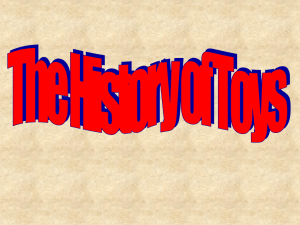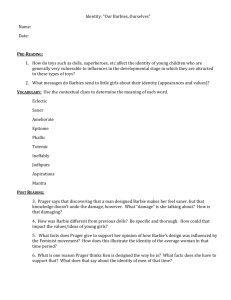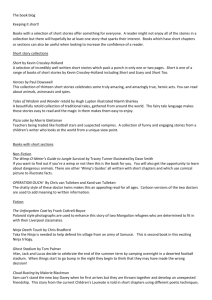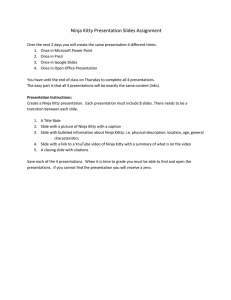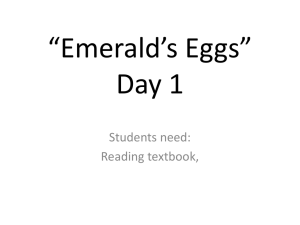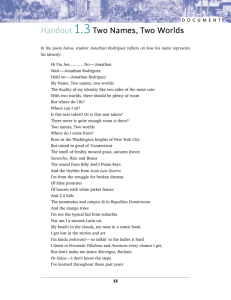WRITING INTRODUCTIONS
advertisement
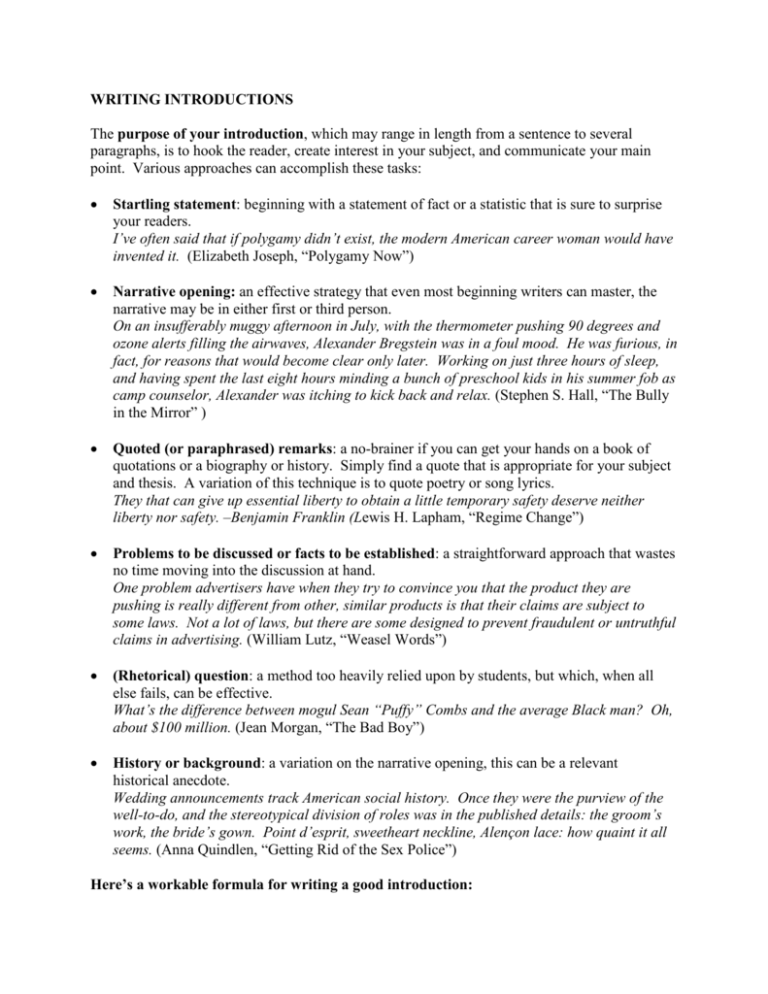
WRITING INTRODUCTIONS The purpose of your introduction, which may range in length from a sentence to several paragraphs, is to hook the reader, create interest in your subject, and communicate your main point. Various approaches can accomplish these tasks: • Startling statement: beginning with a statement of fact or a statistic that is sure to surprise your readers. I’ve often said that if polygamy didn’t exist, the modern American career woman would have invented it. (Elizabeth Joseph, “Polygamy Now”) • Narrative opening: an effective strategy that even most beginning writers can master, the narrative may be in either first or third person. On an insufferably muggy afternoon in July, with the thermometer pushing 90 degrees and ozone alerts filling the airwaves, Alexander Bregstein was in a foul mood. He was furious, in fact, for reasons that would become clear only later. Working on just three hours of sleep, and having spent the last eight hours minding a bunch of preschool kids in his summer fob as camp counselor, Alexander was itching to kick back and relax. (Stephen S. Hall, “The Bully in the Mirror” ) • Quoted (or paraphrased) remarks: a no-brainer if you can get your hands on a book of quotations or a biography or history. Simply find a quote that is appropriate for your subject and thesis. A variation of this technique is to quote poetry or song lyrics. They that can give up essential liberty to obtain a little temporary safety deserve neither liberty nor safety. –Benjamin Franklin (Lewis H. Lapham, “Regime Change”) • Problems to be discussed or facts to be established: a straightforward approach that wastes no time moving into the discussion at hand. One problem advertisers have when they try to convince you that the product they are pushing is really different from other, similar products is that their claims are subject to some laws. Not a lot of laws, but there are some designed to prevent fraudulent or untruthful claims in advertising. (William Lutz, “Weasel Words”) • (Rhetorical) question: a method too heavily relied upon by students, but which, when all else fails, can be effective. What’s the difference between mogul Sean “Puffy” Combs and the average Black man? Oh, about $100 million. (Jean Morgan, “The Bad Boy”) • History or background: a variation on the narrative opening, this can be a relevant historical anecdote. Wedding announcements track American social history. Once they were the purview of the well-to-do, and the stereotypical division of roles was in the published details: the groom’s work, the bride’s gown. Point d’esprit, sweetheart neckline, Alençon lace: how quaint it all seems. (Anna Quindlen, “Getting Rid of the Sex Police”) Here’s a workable formula for writing a good introduction: • • • • Start with an example (or with any of the other attention-getters listed above). Explain what the example is an example of and thus introduce the subject. If your topic is controversial, briefly outline the most common positions in the controversy. End your introduction by stating your thesis, by taking a position on your (controversial) subject. Here’s an example of the introduction a student wrote according to the above method: When I was a kid, Ninja Turtles were my world. I must have had enough of their action figures to fill a UNO dorm room. Every Saturday morning the Turtles would protect me from such horrors as dog-sized brains named Krang and half-man, half-rhino street punks. Unfortunately, the Ninja Turtles are also responsible for my most embarrassing childhood story. When I was four, I was waiting at the airport for my father to come home from a business trip. He arrived with a box in his hand. It was a Ninja Turtle pajama set. It was like a costume with a shell on the back and everything. I proceeded to remove all of my clothing in the middle of the airport so I could proudly wear the green colors of my Saturday morning heroes. My parents have told that story to every single friend and girlfriend I have ever had. Obviously, the Ninja Turtles had a huge amount of influence on my life, and playing with them left me with many treasured memories. But I can’t help but wonder if I’d feel the same if I was a young girl playing with toys such as Barbie dolls. Male toys such as G. I. Joe and HeMan are action-oriented; they live for adventure. Barbie has a much more limited agenda than G. I. Joe: Barbie shops, changes clothes, gets makeovers, and occasionally takes a drive in her convertible. As a result, these toys reinforce gender stereotypes and influence the way boys and girls think of themselves once they grow up. Boys learn from their toys that men are active in their adventures and perhaps their jobs. Girls learn that what matters in women is their physical appearance. All of the above examples are taken from Fink and Gautreaux, Reading Life.

